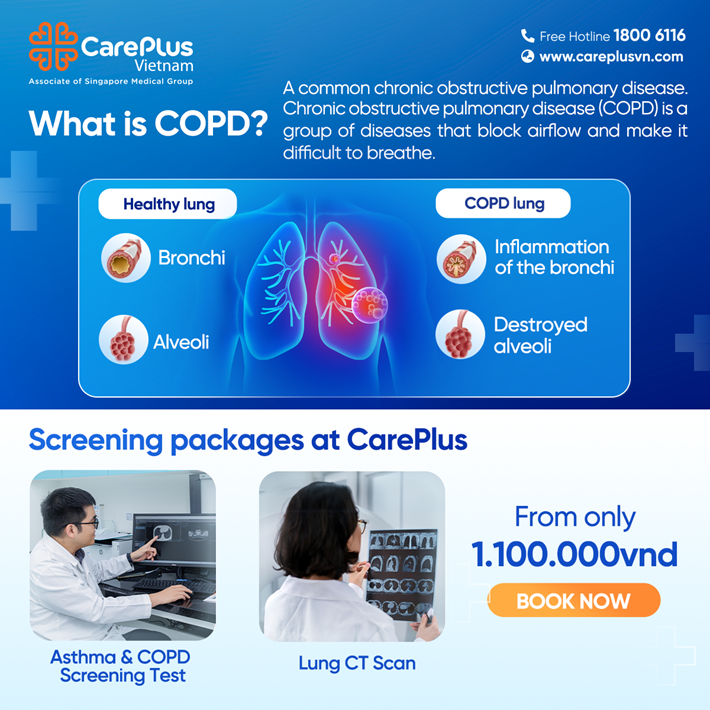COPD – The Silent but Common Lung Disease

10/22/2025 10:35:16 AM
Chronic Obstructive Pulmonary Disease (COPD) is a very common chronic lung condition, yet it often receives insufficient attention and awareness.
1. What is COPD? How prevalent and deadly is it?
COPD stands for Chronic Obstructive Pulmonary Disease — a chronic, progressive, and irreversible lung disorder characterized by airflow limitation, making it difficult for patients to breathe. It causes persistent cough and sputum production over a long period of time.
Prevalence and mortality:
- Worldwide: According to the World Health Organization (WHO), more than 3 million people die from COPD each year, ranking it as the third leading cause of death globally, after cardiovascular diseases and cancer.
- In Vietnam: The prevalence of COPD among people aged over 40 years is approximately 4%–7% and is increasing. Many patients are unaware of their condition until serious complications develop.
Although COPD is as dangerous as heart disease, diabetes, or cancer, it is often overlooked because its symptoms progress silently and can easily be mistaken for common respiratory illnesses.
2. Causes of COPD
The primary cause of COPD is long-term exposure to harmful substances that damage the lungs, including:
- Cigarette smoking (including passive smoking) – the leading cause, accounting for 80–90% of cases
- Smoke from cooking fuels such as wood or coal, commonly affecting women cooking in poorly ventilated kitchens
- Air pollution, fine particulate matter (PM2.5), vehicle exhaust, and industrial emissions
- Occupational exposure to dust and chemicals (miners, construction workers, woodworkers, etc.)
- Genetic factors such as alpha-1 antitrypsin deficiency, though this is rare
- Importantly, most causes are preventable, especially through smoking cessation.
3. Symptoms and Health Impact of COPD
COPD develops gradually, with mild initial symptoms that are often ignored. Typical manifestations include:
- Chronic cough (often worse in the morning) with persistent sputum production
- Shortness of breath, initially during exertion (climbing stairs, brisk walking), later even at rest
- Wheezing, chest tightness, and fatigue
- Breathlessness at night or early morning, or during physical activity
Disease progression and consequences:
- COPD cannot be completely cured; once lung damage occurs, it is irreversible
- The disease progressively worsens over time, leading to reduced respiratory function, loss of work capacity, and limited daily activities
- Patients are prone to recurrent respiratory infections and frequent hospitalizations
- In advanced stages, patients may require long-term oxygen therapy or mechanical ventilation at home
- COPD also increases the risk of cardiovascular disease, depression, osteoporosis, and may worsen existing comorbidities
4. How to Know If You Have COPD
Early symptoms often include chronic cough and sputum, which are easily overlooked.
When persistent shortness of breath, chest tightness, or fatigue on exertion occurs, COPD should be suspected.
The most accurate diagnostic method is spirometry – a simple, non-invasive test that measures lung function and determines the degree of airflow obstruction.
5. Who Should Be Screened for COPD?
Individuals aged 40 years or older, especially men in high-risk groups, should undergo regular spirometry screening if they:
- Have a history of smoking (including former smokers)
- Are frequently exposed to smoke, dust, or industrial pollutants
- Have chronic cough, sputum production, or shortness of breath during exertion
- Have a history of recurrent respiratory infections
6. Benefits of Early Detection and Treatment
COPD can be detected early through chest X-ray and spirometry, which are both simple procedures.
Early detection is crucial because it allows for:
- Better disease control
- Slower disease progression
- Reduced risk of hospitalization
- With early treatment, smoking cessation, and proper breathing exercises, patients can breathe easier, improve quality of life, and avoid serious complications.
In Summary
- COPD is a chronic respiratory disease causing irreversible airflow limitation
- It is common and ranks as the third leading cause of death worldwide
- Smoking and exposure to harmful airborne pollutants are the main causes
- The disease progresses silently, often detected only at advanced stages
- Spirometry is a simple and reliable test for early diagnosis
- Early screening and treatment can slow progression and improve outcomes
References
- World Health Organization (WHO) – Chronic Obstructive Pulmonary Disease (COPD)
- World Health Organization (WHO) – Chronic Obstructive Pulmonary Disease (COPD) in Viet Nam
- Ministry of Health of Viet Nam & National Lung Hospital